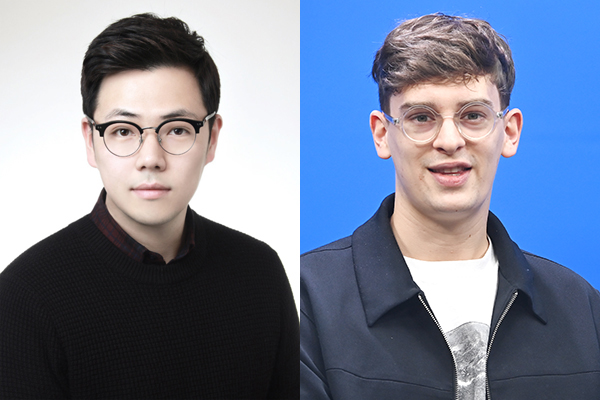커뮤니티
부경투데이
- 국립 부경대학교의 다양한 모습과 소식을 접하시면 부경대학교가 한번 더 가까워집니다.
| 이차전지 미래 연다 | 오필건 교수 연구팀(Paving the way to future secondary batteries | the research team of prof. Oh Pil-Gun) | |||
| 작성자 | 대외협력과 | 작성일 | 2023-04-05 |
| 조회수 | 587 | ||
| 이차전지 미래 연다 | 오필건 교수 연구팀(Paving the way to future secondary batteries | the research team of prof. Oh Pil-Gun) | |||||
 |
대외협력과 |  |
2023-04-05 |  |
587 |
부경대 오필건 교수, 리튬이차전지 안정성 확보 연구 제시
- 재료 분야 국제학술지 <Small>에 논문 게재

△ 오필건 교수(왼쪽)와 엠블턴 톰 제임스 박사과정생.
국립부경대학교는 오필건 교수(나노융합공학과) 연구팀이 리튬이차전지 안정성 확보를 위한 코팅법 연구를 최근 재료 분야의 세계적 학술지 <Small>(Wiley, IF 15.153)에 게재했다고 밝혔다.
부경대 오필건 교수는 엠블턴 톰 제임스 박사과정생(영국)과 함께 진행한 이번 연구에서 Ni(니켈)계 layered 양극 소재 표면 안정화를 위한 코팅 연구 결과를 발표해 성과를 인정받았다.
최근 대형 리튬이차전지 시장이 확대되면서 고에너지, 고안정성을 목표로 고용량 특성에 따른 리튬이차전지 양극 소재의 열화 안정성 확보를 위한 연구가 주요 관심사다.
현재 리튬이차전지에는 Ni(니켈)계 layered 양극재가 가장 많이 사용되는데, 이 양극재는 대기 중 이산화탄소, 수분과 반응해 표면 구조를 열화시키고 잔류 리튬을 형성하는 등 이차전지 용량과 수명을 저하하는 문제가 있다.
오필건 교수 연구팀은 이 양극 소재 표면에 코팅 공정을 적용해 소재와 전해액의 직접적인 접촉을 막는 방식으로 전기화학적, 물리적 안정성을 부여했다.
연구 결과 코팅 공정을 한 양극 소재는 고온 다습한 환경의 노출에도 견디는 것은 물론, 산업 현장에서 하이니켈 양극재 보관과 운송, 이차전지 제조과정에서도 소재의 열화를 최소화하는 것으로 나타났다.
오필건 교수는 “이번 연구는 기존 상용화 양극 소재의 성능을 극대화하는 연구로서 의의가 있다. 앞으로 이 분야에서 현재의 이차입자 형태 소재를 단입자화하는 연구와 폐 양극 소재를 열처리해 재사용하는 다이렉트 리사이클링 연구에도 정부, 기업의 투자가 필요하다.”라고 밝혔다.
한편 이번 연구는 오필건 교수 연구팀이 2020년 선정된 연구재단 기초연구실 사업과 2022년 시작된 ‘한국에너지기술평가원의 저탄소 순환을 위한 폐약극 업사이클링 재제조혁신 기술개발’ 과제의 지원을 받아 진행됐다. <부경투데이>
Prof. Oh Pil-Gun proposes research results on securing stability of lithium secondary batteries
- his paper published on <Small>, an international journal of materials
Pukyong National University announced that professor Oh Pil-Gun’s (dept. of nanotechnology engineering) research team recently published a study on the coating method for securing the stability of lithium secondary batteries in <Small> (Wiley, IF 15.153), a world-renowned academic journal of materials.
In this study conducted by professor Oh Pil-Gun at Pukyong National University with phd student Embleton Tom James (UK), he presented the results of a coating study for stabilization of the surface of Ni (nickel)-based layered anode material, and the results of the research were recognized by the academic community.
As the market for large-sized lithium secondary batteries has recently expanded, research to secure deterioration stability of lithium secondary battery cathode materials according to high-capacity characteristics, aiming at high energy and high stability, is a major concern.
Ni (nickel)-based layered cathode materials are mostly used in lithium secondary batteries currently, this cathode material reacts with carbon dioxide and moisture in the atmosphere to deteriorate the surface structure and form residual lithium, which causes problems that decrease the capacity and lifespan of the secondary battery.
Professor Oh Pil-Gun's research team applied a coating process to the surface of the anode material to prevent direct contact between the material and the electrolytes, thereby imparting electrochemical and physical stability.
As a result of the study, it was found that the cathode material subjected to the coating process not only withstands exposure to high-temperature and high-humidity environments, but also minimizes material deterioration during the storage and transportation of high-nickel cathode materials and the manufacturing process of secondary batteries at industrial sites.
Professor Oh Pil-Gun said, “This study is meaningful as a study that maximizes the performance of previously commercially available cathode materials. In this field, I believe that investment from the government and companies is also needed for research on converting current secondary particle-type materials into single particles and direct recycling research that heat-treats and reuses waste anode materials.”
As for this research, it is carried out with the support of the National research foundation of Korea's basic research lab project, which was selected in 2020 by professor Oh Pil-Gun's research team, and the project, ‘development of waste anode upcycling remanufacturing innovation technology for low-carbon circulation’ managed by the Korea institute of energy technology evaluation and planning, which started in 2022. <Pukyong Today>